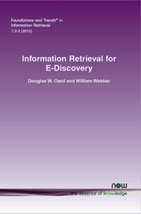Information Retrieval for E-Discovery
By Douglas W. Oard, College of Information Studies and UMIACS, University of Maryland, USA, oard@umd.edu | William Webber, College of Information Studies, University of Maryland, USA, wew@umd.edu
Abstract
E-discovery refers generally to the process by which one party (for example, the plaintiff) is entitled to "discover" evidence in the form of "electronically stored information" that is held by another party (for example, the defendant), and that is relevant to some matter that is the subject of civil litigation (that is, what is commonly called a "lawsuit"). This survey describes the emergence of the field, identifies the information retrieval issues that arise, reviews the work to date on this topic, and summarizes major open issues.
Information Retrieval for E-Discovery
E-discovery refers generally to the process by which one party (for example, the plaintiff) is entitled to discover evidence in the form of electronically stored information that is held by another party (for example, the defendant), and that is relevant to some matter that is the subject of civil litigation (that is, what is commonly called a "lawsuit"). Information Retrieval for E-Discovery describes the emergence of the field, identifies the information retrieval issues that arise, reviews the work to date on this topic, and summarizes major open issues.
Information Retrieval for E-Discovery is an ideal primer for anyone with an interest in e-discovery; be it researchers who first practiced law but now study information retrieval, or those who studied information retrieval but now practice law.
